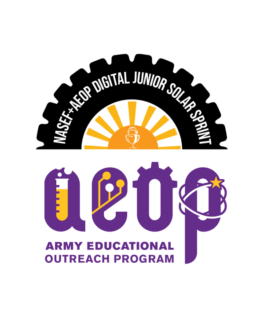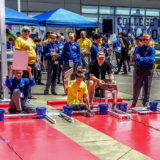January 27, 2022

Are you an avid Minecraft player? AEOP’s Junior Solar Sprint (JSS) is now available on your favorite video game! We teamed up with the North America Scholastic Esports Federation (NASEF) to bring JSS to you virtually through Minecraft: Education Edition.
To help you prepare to build the best and fastest solar-powered vehicle possible, Global Minecraft Mentors and teachers Erik Leitner and Cathy-Cheo Isaacs will teach you the basics of solar power and vehicles through a series of livestreams which start in February. Once you’ve mastered the basics, you’ll be working in a custom Minecraft world designed just for JSS where you can create and test your solar-powered vehicle. Then, once you perfect your design, it’s time to race your vehicle on the track!
Digital JSS is open to ALL 5th-8th grade students, even if there isn’t a JSS competition in your area. Are you ready to race?
Register for Digital JSS here. There is no cost to register and NASEF has committed to provide free Minecraft: Education Edition to participants. Student submissions are due in May. Read more about the partnership in the press release below. Junior Solar Sprint (JSS) is administered by the Technology Student Association. Visit the website to learn more about JSS and register now.
Junior Solar Sprint Goes Digital in Minecraft through Grant Awarded to NASEF by the US AEOP and Technology Student Association
2022 Digital Competition to Build a Solar Car Will Be Open to All 5-8 Grade Students as North America Scholastic Esports Federation Taps into the Power of Minecraft
(Atlanta, GA – December 1, 2021) – The US Army Educational Outreach Program (AEOP) has awarded a grant to the North America Scholastic Esports Federation (NASEF) to present the Junior Solar Sprint competition using one of the most popular programs, Minecraft: Education Edition. Junior Solar Sprint (JSS) is a competition for middle school students to create the fastest, most interesting, and best crafted solar-vehicle possible.
As with the existing JSS events, the digital version will help students grasp the basics of solar energy, physics and movement in vehicles; engineering design principles; and STEM skills like collaboration and communication from working in teams. Additionally, students will build technology and computer skills as they join the program online and through their computers.
The AEOP+NASEF Digital Junior Solar Sprint will be designed for 5th – 8th grade students. The power of a digital competition is that it can be accessed from anywhere in the world; this event will extend the reach of JSS to every state, as well as to students on military bases around the world. There are no barriers to entry due to geography, and NASEF has committed to provide Minecraft free to participants to remove socio-economic barriers that might otherwise be a factor. This will be presented in Minecraft: Education Edition, which can be run on Chromebooks (widely available to most students).
“We’re thrilled to open up this challenge to many more students, including those for whom an online competition will be a brand new experience and student in locations not yet reached by JSS in-person events,” said Sue King, Junior Solar Sprint Manager at the Technology Student Association. “The AEOP+NASEF Digital Junior Solar Sprint will extend the impact of this creative engineering contest to so many more students and families.”
Students will learn about solar power and vehicles through a series of livestreams featuring Global Minecraft Mentors and teachers Erik Leitner and Cathy-Cheo Isaacs. Once they’ve learned the basics, students will work in a custom Minecraft world designed by Cleverlike Studios. They’ll find the elements to build their cars; create and test a solar-powered vehicle; refine the design and try again until they are happy with their creation. They’ll run their cars on the test track to test their speed.
Similar to the traditional JSS presentation of a portfolio, students will submit a Flipgrid video in which they describe their iterative process, the lessons they learned, and details about their solar vehicle.
“Kids love to build in Minecraft, and they learn valuable STEM skills (beyond computer use) as they go,” said Gerald Solomon, NASEF’s founder and executive director. “Together, NASEF, AEOP, and the Technology Student Association will help students learn in a playful format that they love. We can’t wait to see what kind of solar vehicles the kids create in Minecraft!”
NASEF registration[1] for Junior Solar Sprint (and free Minecraft licenses) opens on Monday, January 3, 2022. Details and registration for the event can be found here. The livestreams are scheduled for Tuesdays in February, 2022. Student submissions will be due in May 2022.
About the organizers
The mission of the US Army Educational Outreach program is to provide both students and teachers a collaborative, cohesive, portfolio of Army-sponsored STEM programs that effectively engage, inspire, and attract the next generation of STEM talent through K through graduate programs and expose them to Department of Defense STEM careers. Find them on Facebook and Twitter.
The North America Scholastic Esports Federation (NASEF) is on a mission to provide opportunities for all students to use esports as a platform to acquire STEM/STEAM-based skills and critical communication, collaboration, and problem-solving skills needed to thrive in work and in life. NASEF and its partner HSEL are collaborating to create the leading global esports marketplace and community for play and learning. Find NASEF at NASEF.org and on Twitch, Twitter, Facebook, and Instagram.
# # #

Junior Solar Sprint (JSS)
Junior Solar Sprint (JSS) is a competition for middle school students to create the fastest, most interesting and best crafted solar-vehicle possible.
More About Junior Solar Sprint (JSS)Find a Volunteering Opportunity
Visit our Program Volunteers page for a tool to find the best opportunity for you.
eCYBERMISSION Mini-Grant
The eCYBERMISSION Mini-Grant is intended to support teachers/program leaders as they implement eCYBERMISSION with their teams. Educators (formal and informal) of students in grades 6-9 are encouraged to apply.
